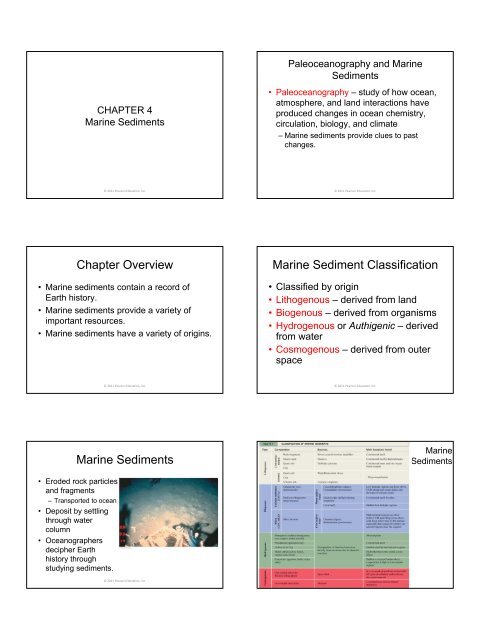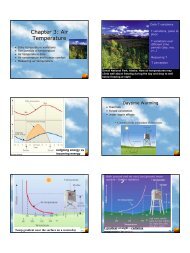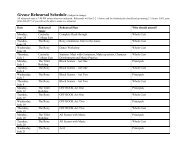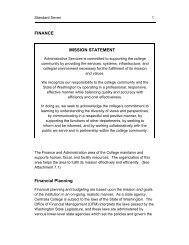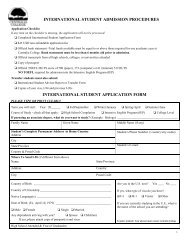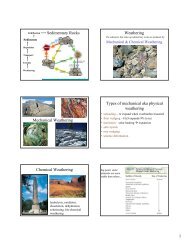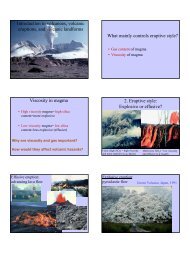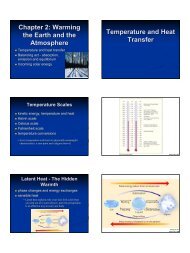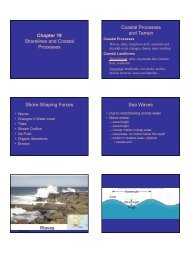Chapter Overview Marine Sediments Marine Sediment Classification
Chapter Overview Marine Sediments Marine Sediment Classification
Chapter Overview Marine Sediments Marine Sediment Classification
You also want an ePaper? Increase the reach of your titles
YUMPU automatically turns print PDFs into web optimized ePapers that Google loves.
CHAPTER 4<strong>Marine</strong> <strong><strong>Sediment</strong>s</strong>Paleoceanography and <strong>Marine</strong><strong><strong>Sediment</strong>s</strong>• Paleoceanography – study of how ocean,atmosphere, and land interactions haveproduced changes in ocean chemistry,circulation, biology, and climate– <strong>Marine</strong> sediments provide clues to pastchanges.© 2011 Pearson Education, Inc.© 2011 Pearson Education, Inc.<strong>Chapter</strong> <strong>Overview</strong>• <strong>Marine</strong> sediments contain a record ofEarth history.• <strong>Marine</strong> sediments provide a variety ofimportant resources.• <strong>Marine</strong> sediments have a variety of origins.<strong>Marine</strong> <strong>Sediment</strong> <strong>Classification</strong>• Classified by origin• Lithogenous – derived from land• Biogenous – derived from organisms• Hydrogenous or Authigenic – derivedfrom water• Cosmogenous – derived from outerspace© 2011 Pearson Education, Inc.© 2011 Pearson Education, Inc.<strong>Marine</strong> <strong><strong>Sediment</strong>s</strong><strong>Marine</strong><strong><strong>Sediment</strong>s</strong>• Eroded rock particlesand fragments– Transported to ocean• Deposit by settlingthrough watercolumn• Oceanographersdecipher Earthhistory throughstudying sediments.© 2011 Pearson Education, Inc.© 2011 Pearson Education, Inc.
Lithogenous <strong><strong>Sediment</strong>s</strong>• Eroded rock fragmentsfrom land• Also called terrigenous• Reflect composition ofrock from which derived• Produced byweathering– Breaking of rocksinto smaller piecesLithogenous <strong><strong>Sediment</strong>s</strong>• Reflect composition ofrock from which derived• Coarser sedimentscloser to shore• Finer sediments fartherfrom shore• Mainly mineral quartz(SiO 2 )© 2011 Pearson Education, Inc.© 2011 Pearson Education, Inc.Lithogenous <strong><strong>Sediment</strong>s</strong>• Small particles eroded and transported• Carried to ocean– Streams–Wind– Glaciers–Gravity• Greatest quantity around continentalmarginsLithogenous Quartz and WindTransport© 2011 Pearson Education, Inc.© 2011 Pearson Education, Inc.Lighogenous <strong>Sediment</strong>TransportGrain Size• Proportional to energy of transportation anddeposition© 2011 Pearson Education, Inc.© 2011 Pearson Education, Inc.
<strong>Sediment</strong> Texture• Grain size sorting– Indication of selectivity of transportationand deposition processes• Textural maturity– Increasing maturity if• Clay content decreases• Sorting increases• Non-quartz minerals decrease• Grains are more rounded (abraded)Pelagic Deposits• Fine-grained material• Accumulates slowly on deep ocean floor• Pelagic lithogenous sediment from– Volcanic ash (volcanic eruptions)– Wind-blown dust– Fine-grained material transported by deepocean currents© 2011 Pearson Education, Inc.© 2011 Pearson Education, Inc.<strong>Sediment</strong> Distribution• Neritic– Shallow-water deposits– Close to land– Dominantly lithogenous– Typically deposited quickly• Pelagic– Deeper-water deposits– Finer-grained sediments– Deposited slowlyPelagic Deposits• Abyssal Clay– At least 70% clay sized particles fromcontinents– Red from oxidized iron (Fe)– Abundant if other sediments absent© 2011 Pearson Education, Inc.© 2011 Pearson Education, Inc.Neritic Lithogenous <strong><strong>Sediment</strong>s</strong>• Beach deposits– Mainly wave-deposited quartz-rich sands• Continental shelf deposits– Relict sediments• Turbidite deposits– Graded bedding• Glacial deposits– High latitude continental shelf– Currently forming by ice raftingBiogenous <strong>Sediment</strong>• Hard remains of once-living organisms• Two major types:– Macroscopic• Visible to naked eye• Shells, bones, teeth– Microscopic• Tiny shells or tests• Biogenic ooze• Mainly algae and protozoans© 2011 Pearson Education, Inc.© 2011 Pearson Education, Inc.
Biogenous <strong>Sediment</strong>Composition• Two most common chemical compounds:– Calcium carbonate (CaCO 3 )– Silica (SiO 2 or SiO 2·nH 2 O)Calcium Carbonate in Biogenic<strong><strong>Sediment</strong>s</strong>• Coccolithophores– Also callednannoplankton– Photosynthetic algae– Coccoliths – individualplates from deadorganism– Rock chalk• Lithified coccolithrichooze© 2011 Pearson Education, Inc.© 2011 Pearson Education, Inc.Silica in Biogenous <strong><strong>Sediment</strong>s</strong>•Diatoms– Photosyntheticalgae– Diatomaceousearth• Radiolarians– Protozoans– Use externalfoodCalcium Carbonate in Biogenic<strong><strong>Sediment</strong>s</strong>• Foraminifera– Protozoans– Use externalfood– Calcareous ooze© 2011 Pearson Education, Inc.© 2011 Pearson Education, Inc.Silica in Biogenous <strong><strong>Sediment</strong>s</strong>• Tests from diatomsand radiolariansgenerate siliceousooze.• Siliceous ooze lithifiesinto diatomaceousearth.Distribution of Biogenous<strong><strong>Sediment</strong>s</strong>• Depends on three processes:– Productivity– Destruction– Dilution© 2011 Pearson Education, Inc.© 2011 Pearson Education, Inc.
Neritic Deposits• Dominated by lithogenous sediment, maycontain biogenous sediment• Carbonate Deposits– Carbonate minerals containing CO 3– <strong>Marine</strong> carbonates primarily limestone –CaCO 3– Most limestones contain fossil shells• Suggests biogenous origin– Ancient marine carbonates constitute 25% ofall sedimentary rocks on Earth.Calcareous Oozeand theCCD© 2011 Pearson Education, Inc.© 2011 Pearson Education, Inc.Carbonate Deposits• Stromatolites– Fine layers ofcarbonate– Warm, shallow-ocean,high salinity– CyanobacteriaCalcareous Ooze and the CCD• Scarce calcareous ooze below 5000 meters(16,400 feet) in modern ocean• Ancient calcareous oozes at greater depths ifmoved by sea floor spreading© 2011 Pearson Education, Inc.© 2011 Pearson Education, Inc.Calcareous Ooze and the CCD• CCD – Calcite compensation depth– Depth where CaCO 3 readily dissolves– Rate of supply = rate at which the shellsdissolve• Warm, shallow ocean saturated withcalcium carbonate• Cool, deep ocean undersaturated withcalcium carbonate– Lysocline – depth at which a significantamount of CaCO 3 begins to dissolve rapidly© 2011 Pearson Education, Inc.Sea Floor Spreading and <strong>Sediment</strong>Accumulation© 2011 Pearson Education, Inc.
Cosmogenous <strong>Marine</strong><strong><strong>Sediment</strong>s</strong>• Macroscopicmeteor debris• Microscopic ironnickeland silicatespherules (smallglobular masses)– Tektites– Space dust• Overall,insignificantproportion ofmarine sediments© 2011 Pearson Education, Inc.Pelagic and Neritic <strong>Sediment</strong>Distribution• Distribution controlled by– Proximity to sources of lithogenoussediments– Productivity of microscopic marineorganisms– Depth of water– Sea floor features© 2011 Pearson Education, Inc.<strong>Marine</strong> <strong>Sediment</strong> Mixtures• Usually mixture of different sediment types• Typically one sediment type dominates in different areasof the sea floor.Pelagic <strong>Sediment</strong> Types© 2011 Pearson Education, Inc.© 2011 Pearson Education, Inc.Pelagic and Neritic <strong>Sediment</strong> Distribution• Neritic sediments cover about ¼ of the sea floor.• Pelagic sediments cover about ¾ of the sea floor.Sea Floor <strong><strong>Sediment</strong>s</strong> RepresentSurface Ocean Conditions• Microscopic tests sinkslowly from surfaceocean to sea floor(10-50 years)• Tests could bemoved horizontally• Most biogenoustests clump togetherin fecal pellets– Fecal pellets largeenough to sinkquickly (10-15 days)© 2011 Pearson Education, Inc.© 2011 Pearson Education, Inc.
Worldwide <strong>Marine</strong> <strong>Sediment</strong> ThicknessDistribution of ManganeseNodules© 2011 Pearson Education, Inc.© 2011 Pearson Education, Inc.Resources from <strong>Marine</strong><strong><strong>Sediment</strong>s</strong>• Energy resources– Petroleum• Mainly from continental shelves– Gas hydrates• Sand and gravel (including tin, gold, andso on)• Evaporative salts• Phosphorite• Manganese nodules and crusts© 2011 Pearson Education, Inc.End of CHAPTER 4<strong>Marine</strong> <strong><strong>Sediment</strong>s</strong>© 2011 Pearson Education, Inc.Mining Sea Salt© 2011 Pearson Education, Inc.


